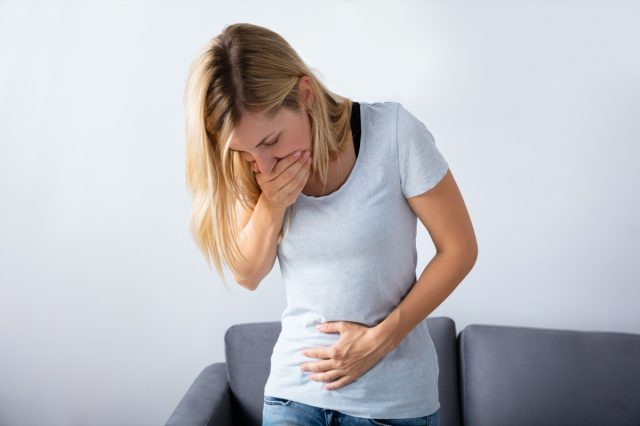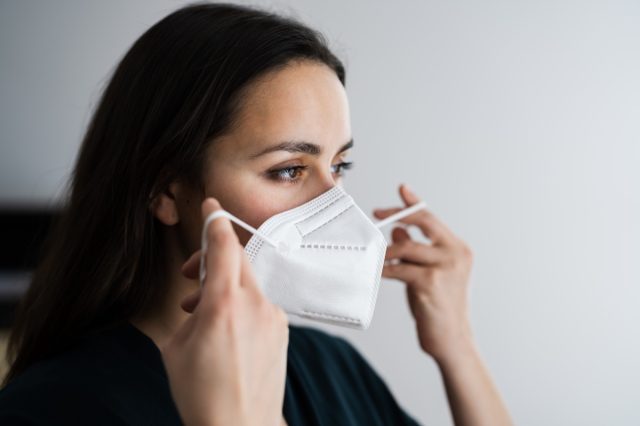COVID cases are finally declining in the U.S., but the pandemic isn’t over by any means. The virus is still infecting people daily and new variants are popping up, which is causing concern from infectious disease experts. While COVID affects everyone differently, symptoms usually appear in a certain order and Eat This, Not That! Health spoke with Dr. Sunjya Schweig, MD, Founder and President of the California Center for Functional Medicine who explained patterns to watch out for. Read on—and to ensure your health and the health of others, don’t miss these Sure Signs You’ve Already Had COVID.
1
Fever and Fatigue are Usually the First Signs of COVID

Shutterstock
Dr. Schweig shares, “COVID-19 presents itself in a variable and ranging manner, as some people are asymptomatic and others have severe illnesses. While symptoms of COVID and the order they occur in vary considerably from person to person, there are some common trends in the order in which symptoms occur, as is demonstrated in study from University of Southern California that analyzed rates of symptom incidence in over 55,000 confirmed COVID-19 cases. The most common first symptoms of COVID-19 are fever and notable fatigue. With the Omicron variant, many people experience sore throat as one of the first symptoms.”
2
A Cough Typically Comes Next


Shutterstock
According to Dr. Schweig, “After the fever, the next most common symptoms are cough. Coughs due to COVID tend to be dry, in comparison to the more wet and mucusy cough of illnesses like the cold or the flu. Over time, the cough can develop into a cycle where the coughing causes irritation and inflammation in the throat, thus worsening the cough and leading to abnormal breathing patterns. Headaches – ranging from mild to severe – can also be common in the first few days of illness.”
3
Muscle Pain


Shutterstock / Roman Samborskyi
Dr. Schweig explains, “The next most common symptom that presents itself is muscle pain. Muscle related pain ranges from being mild to being severe and debilitating, especially when it occurs along with fatigue. This usually lasts for an average of a couple days, depending on age. However, at times it can last much longer and is commonly reported among people with Long COVID.”
4
Vomiting and GI Issues


iStock
“Following those previous symptoms, people usually experience nausea or vomiting, particularly with the Omicron variant,” Dr. Schweig says. Data collected in December and January show patients reporting feeling nauseous and queasy, or having uncontrollable vomiting as one of their primary symptoms. These symptoms tend to present prior or other gastrointestinal COVID-related issues like diarrhea.”
RELATED: Signs You Have Diabetes, Say Physicians
5
What a Severe Case of COVID Looks Like


Shutterstock
Dr. Schweig states, “Severe Covid typically happens a few days after the initial symptoms of fever, fatigue and a cough. The type and severity of severe cases varies significantly from person to person, ranging from pneumonia, to blood clotting emergencies, to acute respiratory distress syndrome. Severe COVID cases require hospitalization and, for some, the use of a ventilator and can potentially lead to respiratory failure, septic shock and/or multiple organ dysfunction.”
RELATED: Sure Signs You Have Atrial Fibrillation, Say Physicians
6
When it’s Time to Seek Medical Attention


Shutterstock
Dr. Schweig says, “Emergency warning signs that it is time to seek treatment include:
- Trouble breathing
- Low oxygen saturation
- Persistent pain or pressure in the chest
- Inability to wake or stay awake
- New onset confusion
- Pale, gray or blue colored skin, lips or nail beds (depending on skin tone)
- Severe nausea, vomiting, or diarrhea that may lead to dehydration
Of note, in addition to vaccination and receiving a booster shot, there are ways that people can potentially protect themselves from more severe illness through healthy lifestyle and dietary supplements. Some key recommendations include:
- Eating a whole foods diet rich in nutrient dense proteins, with as many different vegetables as possible
- Lowering or avoiding sugar and alcohol can help to lower the risk of inflammation in the body and optimize immune function
- Getting adequate sleep and adopting healthy exercise patterns can also help modulate inflammation and immune function
- Adequate hydration is also important for optimal function and recovery from illness. Aim to drink at least ½ your body weight ounces of water daily. For example, if you weigh 150 lbs, aim for 75 ounces of water per day and more if you sweat while exercising or drink alcohol or caffeine, which can act as diuretics.
From a dietary supplement point of view, there are many supplements that can help modulate a variety of inflammatory pathways such as NRF2 and NF Kappa B, such as:
- Vitamin C
- Vitamin D (goal blood level around 50-60)
- Vitamin A (cod liver oil is a good source of Vit D and Vit A)
- Glutathione and its precursor NAC and or sulforaphane
- Alpha Lipoic Acid
- Curcurmin (turmeric)
- Zinc
- Quercetin
- Magnesium
- Melatonin
Note that many of these can be obtained through dietary intake.”
RELATED: Here’s What Lyme Disease Feels Like, Say Physicians
7
How to Stay Safe Out There


Shutterstock
Follow the public health fundamentals and help end this pandemic, no matter where you live—get vaccinated or boosted ASAP; if you live in an area with low vaccination rates, wear an N95 face mask, don’t travel, social distance, avoid large crowds, don’t go indoors with people you’re not sheltering with (especially in bars), practice good hand hygiene, and to protect your life and the lives of others, don’t visit any of these 35 Places You’re Most Likely to Catch COVID.

